#circa 1975/76
Explore tagged Tumblr posts
Text
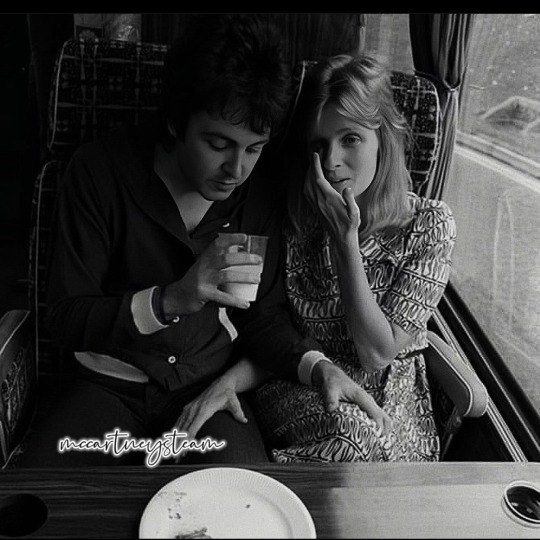
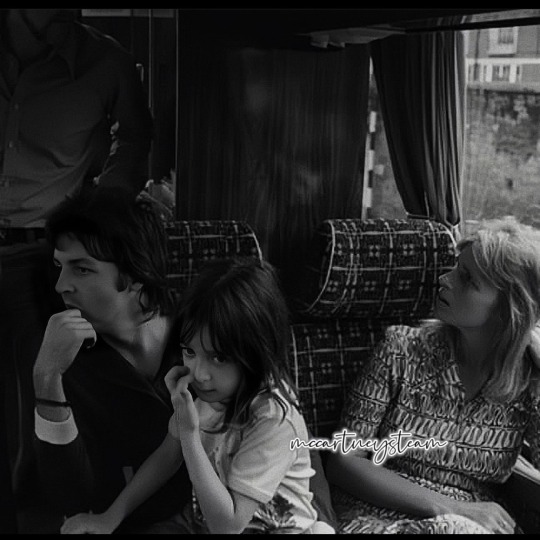
Paul, Linda and Mary McCartney, circa 1975/76🌼
Via @mccartneysteam on Instagram🌼
#60s icons#girlsofthesixties#60s couples#the beatles wives#paul mccartney#linda mccartney#mary mccartney#the mccartney family#circa 1975/76
13 notes
·
View notes
Text

1958 / circa 1975-76. 🤤🥹

#hot and hot#like my god#that crooked smile...#what a gorgeous man#elvis presley#elvis#50s elvis#70s elvis#elvis the king
38 notes
·
View notes
Text

A-7A 152673 assigned to VA-93, circa 1975-76.
20 notes
·
View notes
Text

C3-era Corvette, circa 1975-76.
#chevy#chevrolet#corvette#stingray#c3#70s#1975#1976#yellow#classic#vintage#american#sports#car#50mm#badge#hi-fi fotos#hallewell
22 notes
·
View notes
Text



22 OTTOBRE 1975 ; IL MILAN IN SERIA DIFFICOLTÀ AL ST.MEL’S PARK DI ATHLONE
Le tre foto che ho voluto postare ci raccontano del calcio di una volta e di quando nella Coppa Uefa 1975-76 il piccolo Athlone Town bloccò il Milan sullo 0-0. Albertosi,Anquilletti,Maldera,Turone,Bet,Scala,Gorin,Benetti,Calloni,Bigon,Vincenzi sembravano chiamati ad un facile impegno nella repubblica d’Irlanda quel 22 ottobre del 1975. Un’ottima squadra quella rossonera senza Rivera e con Benetti capitano che il sorteggio mise di fronte ai nerazzurri dell’Athlone Town,una squadra di dilettanti di una piccola cittadina irlandese di 15.000 abitanti a circa 130 chilometri da Dublino. Il calciatori irlandesi erano tutti dilettanti al duecento per cento e il calcio di quelle terre era, allora come oggi,molto meno popolare del rugby e di sport gaelici come l’hurling e il calcio gaelico ; pur tuttavia quel 22 ottobre ad Athlone si presentarono nel piccolo stadio ben 10.000 persone,in pratica quasi tutti gli abitanti della cittadina. Gli irlandesi giocarono con il coltello fra i denti e il Milan non uscì sconfitto solo perché Albertosi paro’ un rigore al bomber irlandese Minnock che nella vita faceva l’allevatore. Al ritorno il Milan vinse facilmente per 3-0 ma la partita di andata ancora ben se la ricordano gli sportivi della cittadina irlandese situata sulle sponde del fiume Shannon quando i nerazzurri del piccolo Athlone Town riuscrono a bloccare sul pareggio il grande Milan.
0 notes
Text
Continued from previous comment...
You always had R&B music artist incorporate a little Latin sound like Reasons by Earth Wind & Fire 1975...with a Cuban style, or Running on the 1977 All N All album. Also Herman Kelly with the 1978 song dance to the drummer beat.
Tito Puente of Puerto Rican background was a musician who played on certain SugarHill rap records.
Carlos Mendez not only cofounded the Cold Crush Brothers circa 1977, but also established the first know hiphop gathering or convention, circa 1979-80. At least 2 members of the fearless 4 were of Puerto Rican background in the latter 70s- early 80s. Also a lesser known Mean Machine 1980.
Better known by his stage name Pumpkin, 70s-80s HipHop drummer Errol Eduardo Bedward played on many songs of the genre.
His overall appearance was of a typical African American, but was of Costa Rican and Panamanian background. He spoke fluent Spanish.
Artist he played for include...(1979 to 1984), Grandmaster Flash and the Furious Five Spoonie Gee, Treacherous Three, Funky Four, Grandmaster Caz, the Fearless Four, and Dr. Jeckyll & Mr. Hyde, and several more obscure names. His 1983 single "King of the Beat", Pumpkin and the Profile All-Stars' "Here Comes the Beat" (Profile, 1984).
Puerto Ricans bros like Ken Swift, Crazy Legs, Mr Wiggles, and even Trac 2 (when he was younger and humble😄), said they saw mostly African American youth breaking before like 75-77. Trac is in a 1978 photo with Spy (African American and Spanish). Also Rene and Boss same year. They just won a breaking competition. Crazy legs said Spy was the first person he ever seen do this dance as a 9 year old in 76. Spy was in his early teens. In rare photos from an original RSC (Rock Steady Crew) website, Legs is in 1979-81 photos with forgotten African American members like Ski, Kippy D, Lil Craze, and their 1977 cofounder Jimmy Dee (with PuertoRican friend Lee). I say this so you can see the dance was both African American and Puerto Rican at the same time. You kind of sense that in the old photos (many youth added moves to it that became popular).
In a 2013 gathering celebrating hiphop, Crazy Legs introduced their 1977 African American cofounder, Jimmy Dee, to the crowd. Many never seen him because being a couple of years older (upper teens), he went off to college by time the 80s came around. In a modern Ytb livesteam interview, he says in like 78 this 12 year old, exuberant about the dance dormant in Bronx and Harlem at the time, asked him if they can start a new chapter of RSC before moving to Manhattan. We know this enthusiastic dancer as Crazy Legs
In the 1974 movie "Education of Sonny Carson", coincidently about a African American gang in New York City, the one teen that likes to dance is up-rocking into James Brown like splits (Staten Island boat scene and parade scene). It reminds me when Ken Swift describes old style breaking (before 1976/77) as looking more like FrostyFreeze style ( African American teen in Flashdance who jumps on his back. Movie was filmed in 1981 and released in 83)
In the outtakes of StyleWars, filmed in 81 and released in 83, Kippy D of old Rock Steady Crew informs us that they just incorporated Poplocking from the West coast. This componant lumped into breakin was absolutely African American. A derivative of 1969 locking, created by Don Campbell, POPPIN was introrduced to L.A. youth by African American Boogaloo Sam and his brother Poppin Pete (African American) of Fresno, CA, circa 1976. So it's like it came full circle back to L.A - stemming from lockin). Debuted on SoulTrain in 1978 by Jeff Danials and his crew, it became a popular dance of young people and performers at the time (1978 thru 83-ish).
Another interesting detail in StyleWars (filmed in 81...important to emphasize that here), Frosty Freeze tells the interviewer that the dance started in Bronx as well as parts of Harlem.
Rock dance is not the base of up rock commonly used in breaking. You have a Puerto Rican Rock dancer of 70s Brooklyn saying he seen breaking in the Bronx circa 1975 and it looked nothing like what they did. It appears that rocking was feet shuffling while uprocking was more jumping and arm swinging movements. Even Brooklyn Rock Dance, with it's mysterious origin, shows more affinity to African American style than Latino.
In the 1950s African American teens created their own form of Mambo. (Look up Brooklyn Mambo, 1950s). It's very close to RockDance. Even in some of the footage Spirit Moves between the 1920s -50s, similarities show up here and there. So far we can't find videos of Latin dance in this manner concurrent to that 50s era. Uprockin for breakin comes from Spade Dance (Black Spades, 60s - early 70s Bronx gang). Just like C-walking (Crip Walk 1970s), people just forgot over time the African American street culture these styles are based on. In the history of Melbourne Shuffle, no one seems to mention or allude to the fact they're C-Walking with a little 80s New Jack Swing...sped up. This is the same scenario in not recognizing Uprock being originally Spade Dance. In a 1990, hiphop doc, PeeWee Dance, an original ZuluKing member, hangs with RSC as he demonstrates the raw essence of what they did in the early 70s. He is SpadeDancing/Uprockin/BronxBurning/Going Off (video should be on Ytb...YOU GET THE SENCE OF WHY THEY CALLED IT GOING OFF)
Graffiti art was born in 60s NYC and included many races of people. Black, Hispanic, Italian, and even firsthand accounts of Asian. There's no definitive evidence that it came from Philly of the 60s
God bless (see Biblical Salvation
0 notes
Text
Tutti gli UFO sopra Firenze dalla guerra ad oggi: 1975 terza parte


Ci credete? Non ci credete? Poco importa. Il fenomeno ufologico è vecchio quanto il mondo. Gli avvistamenti, reali, finti, "costruiti" nel mondo sono innumerevoli e su Firenze e provincia non mancano. Questa è un piccola rubrica per citare gli avvistamenti registrati su Firenze e provincia dal 1946 al 1980, se poi qualcuno ha a disposizione anche quelli successivi, e ce li fornisce, potremmo pubblicare anche quelli dal 1980 in poi. Questo l'articolo precedente: Tutti gli UFO sopra Firenze dalla guerra ad oggi: 1975 seconda parte Il 6 o 7 luglio 1975 nei cieli di Firenze alle 18:00/18:15 fu visto un corpo discoidale, lo riporta Il Giornale dei Misteri n. 76, doc. 1814 La famiglia Corti, composta dal padre Alfredo di anni 47 e di professione vigile urbano, dalla moglie Maria Simonetti di anni 47, dalla figlia Laura di anni 19 e dal figlio Mauro di anni 15 (tutti residenti in località La Fonte-Bagno a Ripoli, in via Roma) mentre rientrava in auto da un viaggio, in località Borselli assistì ad un fenomeno inconsueto. Tutti quanti i componenti la famiglia videro attraversare a folle velocità il cielo da un corpo discoidale, che girava sul proprio asse e che si dirigeva verso Firenze-Prato. Era di colore argenteo e, al vigile, parve che avesse un diametro di 25/30 metri e che si trovasse ad una distanza di 700-1000 metri da loro e che procedesse con assetto di volo leggermente inclinato. Rimase visibile nel cielo sereno fino a che non si disperse in lontananza, dopo 2/3 minuti dalla sua comparsa in direzione di Firenze, sulla quale città sembrò emettere lampi di luce rossa. Tutti i testimoni rimasero impauriti e, tornati a casa, nessuno cenò. Al passaggio dell'oggetto, l'auto perse velocità fino a fermarsi e non fu possibile rimetterla in moto che un'ora dopo il fenomeno. Il 15 luglio 1975 nei cieli di Calenzano alle 00:10 viene visto un oggetto luminoso, lo riporta Archivio CUN di Prato Osservato da tre persone un oggetto luminoso che a forte velocit… si diresse verso monte Morello. 29 settembre 1975 nei cieli di Firenze alle 19:30 fu visto un oggetto volante, lo riporta Il Giornale dei Misteri n. 76, doc. 1812 Beatrice Buonaguidi (via Andreotti 17, Leccio di Calenzano, Firenze), vide, assieme al fratello, un oggetto volante che viaggiava molto lentamente (20 km/h) e dalle dimensioni approssimative di metri 3x2; si trovava a non oltre 250 metri di quota e proveniva dalla Calvana con direzione verso Firenze (da nord a sud). Era di forma a bombetta e sembrò girare su se stesso, procedendo sempre in linea retta in un cielo perfettamente sereno. L'oggetto fu visibile per 30 secondi, dopodichè scomparve all'improvviso. Durante il passaggio di esso, alla testimone parve che tutto attorno vi fosse un gran silenzio. Il 17 ottobre 1975 nei cieli di Firenze alle 21:55 videro un sigaro incandesciente, lo riporta Archivio CUN di Prato Il signor Stefano Gangale (via Erbosa 103 - Prato), suo cugino Marco Ridondelli (via Bracciolini 23 - Firenze) e la sua ragazza Gianna Giannelli (via Cimitero del Pino 16 - Firenze), videro in cielo un oggetto a forma di sigaro, incandescente, che volava lentamente da NE verso SO, lasciando dietro di sè una lunga scia luminosa. Aveva una quota di circa 1500 metri. Per attraversare tutto l'arco del cielo, impiegò circa 10 minuti, visto che andava lentamente, ma ad un tratto aumentò la sua velocità sparendo nella frazione di pochi secondi. Il cielo era prevalentemente nuvoloso e l'oggetto si è sempre mantenuto al di sotto delle nubi. Nessun rumore fu percepito. 22 ottobre 1975 nel cielo di Firenze alle 13:10 fu visto un oggetto immobile, lo riporta Archivio CUN di Prato Il signor Marco Ridondelli e suo padre Attilio Ridondelli, dalla terrazza della loro abitazione di via Bracciolini 23 in Firenze, videro un oggetto più grande di una stella di prima grandezza, che stazionava immobile a circa 20.000 metri. Preso un binocolo ("Jamatar" 10x50) si notava chiaramente che l'oggetto era metallico e che era circondato da una luminescenza bluastro-arancione. Poco dopo fu osservato anche con un telescopio "Astron D=5 F=610, e fu notato che l'oggetto aveva la caratteristica di una capsula "Gemini", senza però poter distinguere bene i contorni sulla destra dello stesso. Da fermo l'oggetto poi salì, dopo alcuni minuti di stazionamento, verso l'alto dove scomparve. Il cielo era perfettamente sereno. Read the full article
0 notes
Text
Breakin and Poppin History
This is an old post I saved. Check it out because there's some pertinent info from the pioneers on it's origins.Kind of long, so check it out in sequence at your leisure
"Breakin" and Poppin history
These are 2 separate dances. One from the West cost, the other from the East coast. It can be argued that both came from the western United States in the black community of L.A. ( Watts and Compton) The pioneers from NYC said that the basis on how they formated their style, was L.A.'s "locking" style. What ever the case, it was all seeded by African American youth. Breakdancing was created by black youth of Bronx, NY, mainly the Zulu Kings and Jr Black Spades, trying to one-up on each other at the early KoolHerc jams. The earliest recollection people have of it is 1973. Puerto Rican youth picked up on it circa 1975-76 by their own accounts, and they made a huge contribution to the development of the dance. Also creating groups around it and refining it even more. They brought the dance into the 80s were it spread like wildfire in the mainstream . It's AfroAmerican and Puerto Rican orgins where a distant memory as early as 1983
The media coined the term " breakdancing" in the early 80s as it's popularity spread. According to some of the Hispanic pioneers, the original black youth never gave it a name, but would sometimes loosely refer to the dance as " going to the floor". According to a Rock Steady member in the documentary "Freshest Kids" they had a name in the 70s to denote the original AfroAmerican style of the earlier 70s... The term was "Moreno style". In the latter 70s some called it "B- Boying.
Lockin was created by L.A.’s Don Campbell (African American) in the late 60s. The concept spread to Fresno CA, where a new derivative of locking was developed. We now know it as Popping. Imported into L.A. from Fresno by two young African American streetdancers named "Boogaloo Sam and his brother Poppin Pete (circa 75 - 76), it debuted nationally in 1978 via Soultrain. Many youngsters and performers picked up on it soon after. Poppin was all lumped into breaking later. A hyped up resurgence of breaking and Popping was created by black and Hispanic youth of L.A. starting around 1986-1990. Also by east coast groups like the extended Rock Steady Crew. With it's airmoves and extensive spins, this form is still practiced by people of many ethnic groups. Even tournaments worldwide
Though originally a African American youth dance of the early 70s, Puerto Rican youth made a huge contribution to the development of breakin. The orginal Rock Steady Crew of the latter 1970s through the very early 80s
1
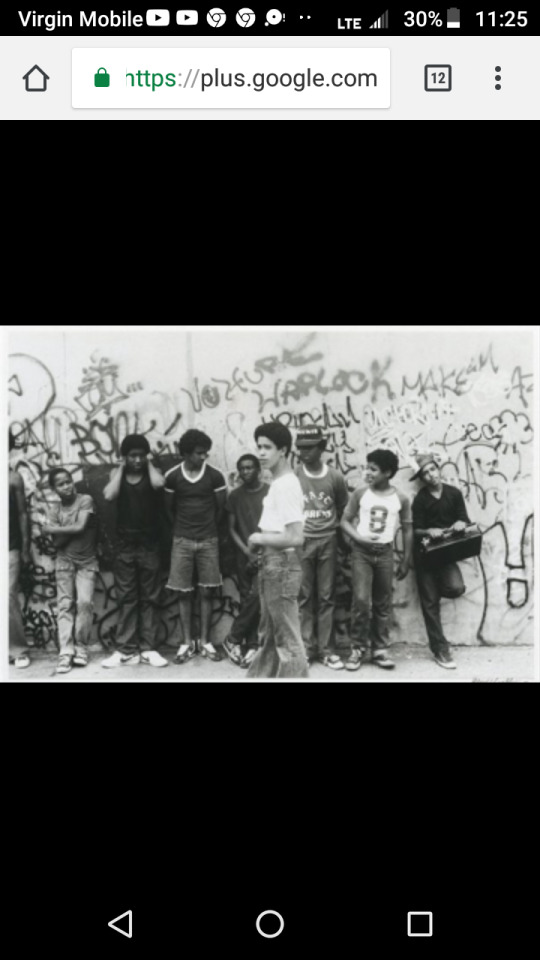
2
Filmed in front of Lincoln Center 1981, by a NYC tv station, this is before the dance was really known around the country, and dormant in those circles in Bronx ---and according to renowned Frosty Freeze in an early 80s documentary, parts of Harlem.
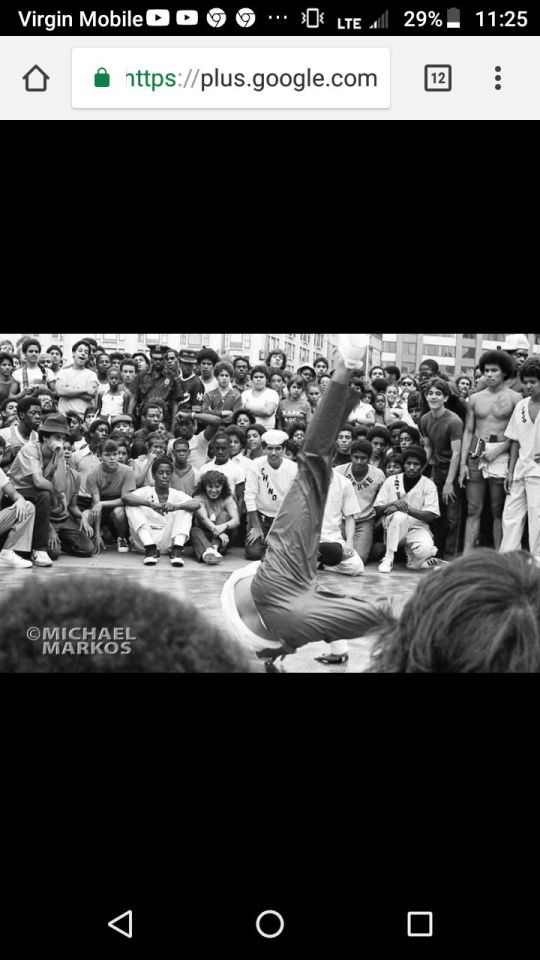
3
https://i.pinimg.com/originals/b9/ca/ff/b9caff2fa5cc9394e25ab2b0c329b687.png
4

5

70s (?)
Rene, Trac2, and Boss appearantly won a competition in 1978
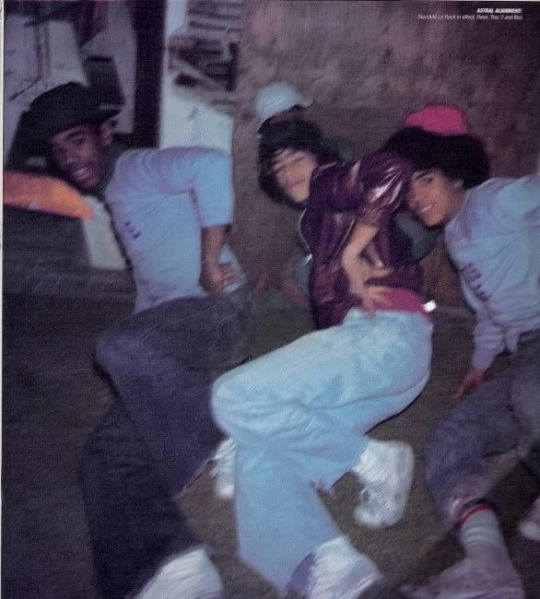
Obviously the late 70s to very early 80s. The Puerto Rican youth in the center is the renowned Ken Swift and the black youth with his arms folded to the left is " Lil Crazy from the late 70s RSC, and to the right next the girl is forgotten member Kippy D.
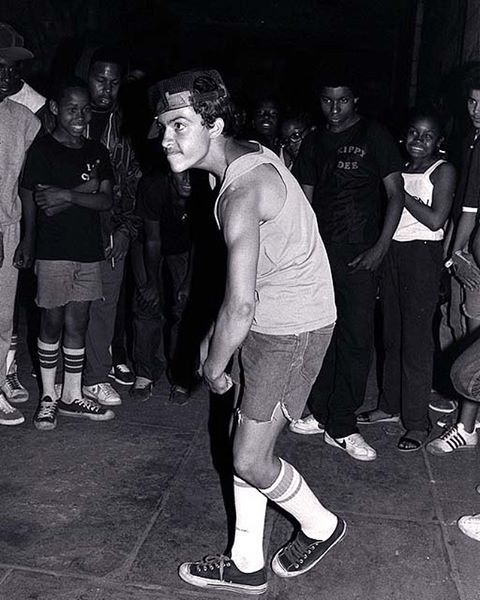
The founders say there were actually 2 different crews who joined together to form the RSC. It was TBB (The Bronx Boys) from the mid 70s and Rock City of the 70s Bronx and Manhattan. Here's Louie Lou and Frosty from the Rock City days

Miscellaneous images of TBB and Rock Steady from the 70s and very early 80s
Link
Video compilation of 70s pioneers, mostly long forgotten African American " bboys" of that era, performing the style of that decade. Most of these are from like the 1990s and early new millennium. All videos are very brief ( less than 1 minute on most)
Link
WITH ARENA SIZED CROWDS, YOUNG FOLKS TOOK THE DANCE TO ANOTHER LEVEL. THIS IS WHAT THEY DO NOWADAYS
https://txt.fyi/+/7b4d8ead/
Looks like 83/84 (?)

A few original "rockers" of the 70s era ( African American). The picture above are original Rock Steady Crew members from appearantly the 1980s. The young guy at the top right is the very cofounder Jimmy Dee from 1977
Jimmy Dee the co-founder of the RSC in the latter 70s... The original blog is offline now. I will try to recall some basic info he shared with us on the formation of RSC. Crazy Legs asked him to write a brief summary on this. He laughed because he'd heard about dozen or so stories on how they formed - and thought it to be less important where they came from, but more relevant of what breaking and Rock Steady has become. A quick detailed story was shared from the very cofounder..
A few of them branched out from a larger mid 70s group called TBB (The Bromx Boys) to form a group of their own. With the blessings of the former group, they formed RSC (no falling out between members like Batch as some rumors had it). It was names like Jim Lee, JoJo, Popeye and a few others. He met a new recruit named Crazy legs - who was excited and determine to be the best. Not long after, Jimmy went off to college but still loosely associated with and keep up on RSC over the years. Also astonished at what it has become in modern times

Video link is in the compilation TBB RSC by shwat2013. The Rock Steady Crew @ Central Park, NYC - YouTube. At about the last 1/8 of video, Crazy Legs introduces the 1977 cofounder ( African American) to the crowd at a 2013 hip-hop reunion in Central park. Many never heard of or seen, because he went off to college ( circa early 80s)
These are from around 1981, NYC
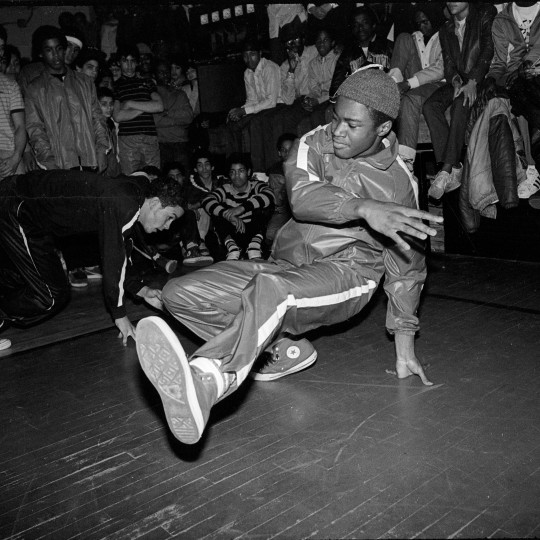
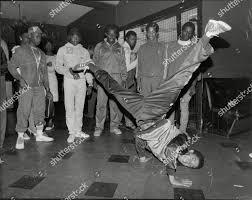
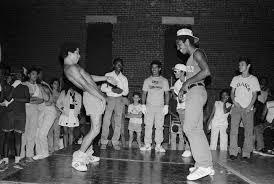
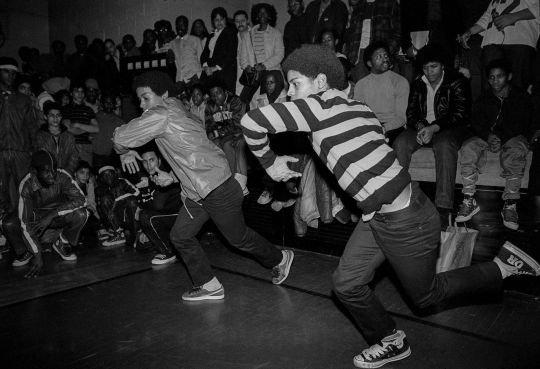
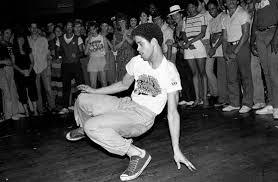

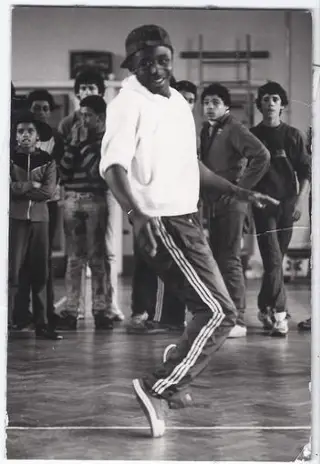


1 https://www.pinterest.com/pin/631981760196661962/
2 (1977) https://i.pinimg.com/originals/1c/1b/99/1c1b99f349c13eab206133419375e96d.jpg
3 From the 1981 Lincoln Center battle. Some of the footage was used in the 1982 video for Planet Rock and Buffalo Gals 83 https://i.pinimg.com/originals/90/60/35/906035b98a0a209b096cf0cc09ffd5b3.jpg
Spy from the mid to latter 70s. In a 2002 documentary, Crazy legs stated that Spy was the first person he had ever seen doing the dance as a 10 year old in 1976. Spy was roughly early teens. There are others who say that he was the best breaker they had ever seen in the decade of the 70s - hands down
1 https://www.pinterest.com/pin/631981760196661910/
2 1979 https://www.pinterest.com/pin/631981760196662004
? Circa mid 70s https://www.pinterest.com/pin/631981760196662268/
Puerto Rican youth appearantly added spin moves and certain uprock styles to the dance format. This is from the Ed Sullivan show of 1957. Pay attention at 1:00 and 1:18
Link
youtube
Seen in old African American performers
In 1894, the Edison Production company filmed 3 African American performers named Joe Rastus · Denny Tolliver · Walter Wilkins, who are clearly uprocking into breaking moves. The film was entitled The Pickaninny Dance, from the 'Passing Show' · Director. William K.L. Dickson · Writer. Sydney Rosenfeld ·
youtube
1
1960s
https://youtu.be/JfnhSJPfHNI?si=zGYySUiBGDAdTTSQ
2
1920s - 50s
.https://youtu.be/Nld6odfRJws?si=KomuY2Sd4iiBPfdX
Basically rapping and breaking 1930
1
https://youtu.be/SVBpB7rSn7A?si=geEgw6BGCZVIkYk5
Modern beat added
https://youtu.be/Iat62Ab87qs
2
Little Buck 1955
https://youtu.be/DpV2Xl4e4YQ?si=i6p35SJqhXBaMeee
1959 Ed Sullivan
https://youtu.be/RlkrtST_OkY?si=SlseWltt1g1uhxcD
In this 1974 footage, Roberto, an Afro Puerto Rican, does the exact moves of Little Buck from 1957, and same sequence, two decades prior
https://youtu.be/DpV2Xl4e4YQ?si=SCZZh0k6jYxauKqQ
Berry Brothers
1
1941
https://youtu.be/fvDixy-U_6Q?si=lYlaLk5s2g4vMb4P
2
https://youtu.be/oOYhdW6sxoM?si=SnD2qJTqZjfsmoZr
Even though the youth of Bronx and Harlem probably never seen this footage in the early 70s "ghetto" neighborhoods, these type of dance patterns are common in all people.
Nigeria 1959
youtube
"Mainstream"
It's in the dance history of every race
1
.https://youtu.be/4axM1TZtkh0?si=ZkT8OQ6Xy6NxoWGA
2
youtube
Opening scene 1943
.https://youtu.be/-vPlO--nnGM
Actual Zulus of South Africa with traditional dance
https://youtu.be/ej7WTWv-sZI?si=ASb7-ec1WIP0jicG
The first known b-boy crew was ZuluKings of 1973-75 Bronx NYC. This is PeeWee Dance of the 70s crew (roughly early 90s), as he shows original Up top/going off/Burning/SpadeDance (uprocking) style. One Puerto Rican pioneer did mention that old style breaking, the brothers would spend ample time dancing on their feet and floor moves brief at the end
a
https://youtube.com/shorts/0yaupV6dChQ?si=TGw4UAc0EeOc-DIP
b
https://youtu.be/cOVikVl8yts?si=enFjuiCqfjmC8Sk2
c
https://youtu.be/1K8DY2NeaJs?si=K6z8hV9mLhIpDfkw
Video compilation of 70s pioneers, mostly long forgotten African American " bboys" of that era, performing the style of that decade. Most of these are from like the 1990s and early new millennium. All videos are very brief ( less than 1 minute on most)
Outtakes of Flashdance's breaking scene. The RockSteady crew goes back to the essence of the dance. Black guy with Afro goes back to the original group of 1976-77. His moniker was Frosty Freeze. This movie was filmed in 1981 and 82; released 1983 (the original song played in movie was Jimmy Castor's " It's Just Begun 1972)
1
youtube
2
https://youtu.be/ShNmK5DdQO4?si=h40TwVca6I0rlM_0
As seen in the movie, with original Jimmy castor song. This is the first time many viewed the dance which was performed by Rock Steady Crew. Also, the 1983 video "Save the Overtime For Me" by Gladys Knight-featuring the NYC Breakers, was the first nationwide glimps of the dance for some.
youtube
More rare footage of late 70s- mid 80s breaking from the pioneers https://txt.fyi/+/7713cfe2/
WITH ARENA SIZED CROWDS, YOUNG FOLKS TOOK THE DANCE TO ANOTHER LEVEL. THIS IS WHAT THEY DO NOWADAYS https://txt.fyi/+/7b4d8ead/
Best documentary on the "b-boying component of hip-hop. From 2002, it has all pioneers from the 70s. Its African American origins are mentioned from 10;10 through roughly 15;15. Then again from 18;50 through 19;30. At roughly 15;50 through 16;20,, Spy is introduced as one of the first seen in the 70s. The West coast contribution starts at 34;00 https://youtu.be/lKb1vszkeC8
Poppin and Lockin footage
Man on L.A' beach with home movie camera 1981. About midway through, he lucks up and captures youngsters popping. The dance is from 77
youtube
Lockin 1974 https://youtu.be/CQWsF4plYFI
Full version 1974 on Campus scene https://www.youtube.com/watch?v=u6bBNLw_4Nk&list=WL&index=257&t=0s&app=desktop
1978 Lockin (just a ittle over 3 minutes) https://youtu.be/p5eD6dt0NZg
Tho locking is becoming"old hat" at this time, young blks of 1979 still practice, but this time incorporating a touch of popping into their routine. As stated before, it's a derivative of locking anyway. https://youtu.be/n2LSkizYmpM
From the show "What's Happening" in the mid 70s. The character "Rerun" is an early pioneer of that dance style. The Lockers display a faint hint of poppin (2:30 minutes) https://www.youtube.com/watch?v=o6CU8eUjIP4&t=8s
Poplockin 1983 with JazzyJ from Soul Sonic Force https://youtu.be/pyYXcY9KwpE
Kango and Dr Ice of UTFO perform popping and boogaloo in 1983 (slightly before they're known). They clear up the differences between that and Breaking https://youtu.be/1EG4ksiblMs
The renowned Boogaloo Srimp ( Turbo) has an outstanding performance in this 1983 footage; starting around 0:40 https://youtu.be/QJ6IAouIyLA
Best documentary(s) on West coast hip hop. The first is from 1983, and the second from present day YouTube. The second one is by a man who has the credentials to educate on hiphop's history. Researching and interview these artist for a few decades, many of these MC's and DJ's he knows personally. Exellemt docs on the history. You may want to save in a watch later playlist. Both are over an hour long
1 https://youtu.be/GFkgObeA8AU
2 https://www.youtube.com/watch?v=RKvrT0orI5s&list=WL&index=2&t=15s
Lindy hop 1930s - 40s
Was created in the Harlem Renaissance of the 1920s, and popularized in the late 30s and 40's. It spread to young Americans of all races in the 40s
1 (1939)
youtube
2
3
Second scene from 1941
youtube
4
1944 from African American made movie
.https://youtu.be/2Jm5zIXWLEs?si=Bpo3Ojvh8ixPuWF_
5
"Old Hat" by the 1950s, but still practiced
1
youtube
2
3
Be sure to stop at the bottom where it says "More from @afrcnamrcn-23". Don't be distracted by the pictures and links under that. They will occur again so that you can continue with the main post in sequence
.
1 note
·
View note
Text







Wings over America tour photos, circa 1975-76, featuring Paul McCartney, Linda McCartney, and Jimmy McCulloch and others. (www.paulmccartney.com)
135 notes
·
View notes
Text

Angus Young, Malcolm Young, Bon Scott, and Mark Evans of AC/DC circa 1975-76.
#acdc#ac/dc#ac dc#malcolm young#angus young#bon scott#mark evans#why does angus look like a model omg#also lol’ing at the way the sign above them is cropped so it just says SMOKING#it’s appropriate for our boys lol
12 notes
·
View notes
Text
Queen's Cursed Hair
Basically 1970 was not a good year for anyone's hair here. Brian what is on your head, sir???

Roger Taylor's worst hairdo. I think circa 1975. The backdrop of the interview isn't helping but luckily this hairstyle didn't stay long.

John Deacon's worst hair is very hard to find, he has a huge variety of hairstyles but nothing very cursed. This one, circa 1975, is not the best but hopefully it got much better! It's the bangs for me... 😅

Freddie Mercury's cursed hairstyles. I'm so sorry Freddie but your bad hairstyles are probably the worst in the entire band. Starting with the Cursed Hair of 76. Oh boy...

And then, the "What kind of last-minute haircut made this happen??? Sue the hairdresser" of 1980. Although it kind of came back in 1982 in the video for Calling All Girls. It is especially prominent in the Play the Game video. Freddie, who did this to you ??

And finally Brian's hair is always fabulous (apart from that early stumble) because he owns the CURLS.
Thank you for coming to my TED talk 😌
#this is for fun of course I'm sure they all looked back on their hairstyles with a lot of laughs and embarassement 😅#they have way more good looks than bad tho#i think I'm gonna do a best hairstyles post soon#queen#smile#freddie mercury#brian may#john deacon#roger taylor
14 notes
·
View notes
Photo

Day 14: #mayvinylchallenge : Cool | Strange | Favorite Center Labels At its base, a center label is merely there to perform the function that any label is supposed to: for identification, informational and distinguishing purposes. But like anything, art will always make something stand out and be more recognizable...special. So when it comes to the multimedia extravaganza that can potentially be the vinyl record and its center label, one should seriously investigate what one can accomplish art-wise with those 4 diameter inches. Here are just some choice choices for dope center labels in my collection: P1| l to r: 🔺️ Washed Out - Mister Mellow [2017] 🔺️ Devo - Live 1980 [2019 Black Friday RSD] P2| squares top to bottom; rectangle: 🔺️ Prince - His Majesty's Pop Life: The Purple Mix Club [1985; 2019] 🔺️ Duck Sauce - Quack [2014] 🔺️ Prince and the Revolution - Purple Rain [1984] P3| rectangle; squares top to bottom: 🔺️ The Specials - S/T [1980] 🔺️ Sasac - Ultra [2013] 🔺️ The Police - Ghost In The Machine [1981] P4| super special Korean pressing addition! 🔺️ The Brothers Johnson - Look Out For #1 [1976] (Since they've been going around a bit, I thought I would show one of my dad's Korean-bought vinyl records, as he was stationed there in the Army circa 1975-76.) Today's theme brought to you by: @nuski_jomz and @scorchedearth1970 Vinyl Challenge conduit: @jennn_erator Photo by: @rosemcgiggles #vinylcommunity #vinylchallenge #vinyllust #vinyllife #vinyl #vinylcollector #records #recordcollection #wreckastow #coolstrangefavoritecenterlabels #centerlabels #washedout #devo #prince #princeandtherevolution #ducksauce #thespecials #sasac #thepolice #thebrothersjohnson #dopeness #chrislebrane https://www.instagram.com/p/CAMJA2fnPpS/?igshid=115v1np3aasbn
#mayvinylchallenge#1#vinylcommunity#vinylchallenge#vinyllust#vinyllife#vinyl#vinylcollector#records#recordcollection#wreckastow#coolstrangefavoritecenterlabels#centerlabels#washedout#devo#prince#princeandtherevolution#ducksauce#thespecials#sasac#thepolice#thebrothersjohnson#dopeness#chrislebrane
2 notes
·
View notes
Photo

The Killer Kane Band featuring Blackie Goozeman (aka Blackie Lawless) circa 1975-76
46 notes
·
View notes
Text

A-7A 152673 assigned to VA-93, circa 1975-76.
12 notes
·
View notes
Photo



Potrei peccare di campanilismo, ma Bologna mi pare fu la prima città (e per un bel pezzo l’unica) a erigere un qualche tipo di monumento alla compagine femminile della Resistenza, nel 1975 (già un poco in ritardo, se vogliamo). All'interno del parco di villa Spada (uno dei più belli di Bologna secondo fonti autorevoli tipo me) a ricordare 128 donne partigiane della provincia di Bologna cadute nel corso della lotta di liberazione c'è
un muro di due metri che segue la salita del terreno per circa cinquanta metri e che nella sua parte terminale scompare per divenire lo schienale di una gradinata, ordine superiore di un piccolo anfiteatro rivolto verso la città (*)
Ha un aspetto molto bello, legato alla scelta (consapevole) di materiali deteriorabili che lo rende ancora opera viva con continue aggiunte e rimaneggiamenti in anni successivi di opere accessorie tipicamente realizzate da studenti di scuole elementari, medie e superiori.
e ha un aspetto molto brutto, nell'essere relegato in una zona periferica del parco, che proprio ci vai se ci vuoi andare; alla fine è abbastanza rappresentativo e simbolico pure quello.
Alla fine della gradinata, dietro al mini anfiteatro c’è un’opera che riporta una poesia che Alena Synkova scrisse a 11 anni durante la prigionia nel lager di Terezin:
Vorrei andare da sola Incontro a gente migliore Non so, verso l'ignoto Dove nessuno uccide
Per ricordarne 128 che non hanno potuto raccontare quale sia stato il loro contributo ne piglierei una che ha potuto dire qualcosa, tipo Vinka Kitarovic: http://www.filorossomemoria.it/le-vite/42-partigiane-e-partigiani/76-vinka-kitarovic
63 notes
·
View notes
Text
Chapter 1
NORTH FOX ISLAND, MICHIGAN
Off the coast of Michigan lies an island two miles wide and one mile long. It holds a quaint beach with warm sands and a tree-line full of oaks and pine. During the summer, the water is welcoming, and the dock promises adventure whether one is about to take the plunge off or just getting on the island. In the 70’s, the island was owned by multimillionaire Francis Sheldon, a prominent figure in Michigan. Sheldon, being the pillar of the community, opened a youth camp for troubled boys on the island. Free of charge, free transportation, and even funded by the government, the island was a haven for parents who didn’t know how to help their unruly sons.

North Fox Island seen from above, most likely the view the boys saw flying in.(Photo credit: General Aviation News) https://generalaviationnews.com/2016/07/07/destination-north-fox-island-michigan/
At least it seemed that way, that is until 1976 when an 8-year old resident boy of the island was brought to the hospital. He was so badly beaten and assaulted that he couldn’t even talk. However, once he could, he revealed unimaginable horrors.
Within days, the camp was shut down and getting raided for being one of the biggest child pornography and assault rings in the country. Prominent figures everywhere from educational roles to CEO's to government officials were named as clients and paid to do with the boys as they wanted.
Warrants were issued, suspects named, and the victims’ families waited for what was to come.
But that’s just it, nothing ever happened.

Newspaper article chronicling the Francis Sheldon case. (Photo credit: Reddit: Unresolved) Murders) https://www.reddit.com/r/UnresolvedMysteries/comments/45r09t/the_oakland_county_child_killer_aka_the/
Warrants were not pursued on the suspects until weeks after most of them had time to flee the country, charges were never pressed, and the case was closed. They were reopened after a couple of months when the victims’ families started asking questions again, only to be told nothing could be done.
OAKLAND COUNTY, MICHIGAN
In the same year, 1976, children throughout Detroit and the surrounding areas of Oakland county began to go missing. First, 12-year-old Mark in February of 76, then 12-year-old Jill in December of 76, January of 77 brought 10-year-old Chris, then March of 77 it was 11-year-old Tim. All the children had been suffocated after being fed and bathed. All were dumped on the side of the road in various snowbanks, always a town over from where they were taken. Only the boys had been sexually assaulted.
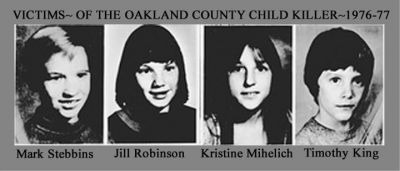
The four murdered children. (Photo credit: True Crime Files) https://thetruecrimefiles.com/oakland-county-child-killer/
But what do the unsolved Oakland County child murders and North Fox Island have in common?
A man named Chris Bush.
Sources:
Broad, Catherine. “NORTH FOX ISLAND, CIRCA 1975-76.” Catherinebroad, 13 Mar. 2013, catherinebroad.blog/2013/03/12/north-fox-island-circa-1975-76/.
Christine, et al. “The Oakland County Child Killer.” The True Crime Files, 23 Apr. 2018, thetruecrimefiles.com/oakland-county-child-killer/.
Flowers, Ashley. “CONSPIRACY: North Fox Island & The Oakland County Child Killer, Part 2.” Crime Junkie Podcast, 16 Dec. 2019, crimejunkiepodcast.com/conspiracy-north-fox-island-the-oakland-county-child-killer-part-2/.
McNamara, Michelle. “Secrets and Lies.” True Crime Diary, 14 June 2011, truecrimediary.com/index.cfm?page=cases&id=132.
#NorthFoxIsland#OaklandCounty#Oakland#michigan#detroit#1970s#true crime#unsolved case#unsolved true crime#child murder#mystery
1 note
·
View note